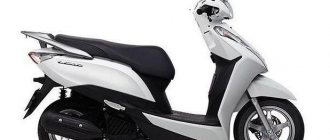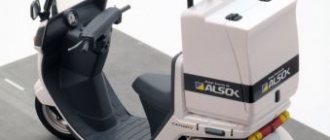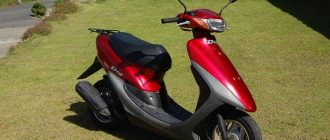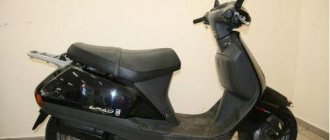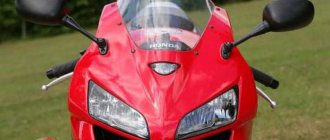The Japanese scooter "Honda Dio 27" was created in 1988. Over twenty-eight years of continuous production, six generations of the miniature vehicle have changed. The Honda Dio 27 moped does not require a driver's license, since its engine displacement is less than fifty cubic centimeters. But the running parameters of the scooter are not inferior to those of a light motorcycle. In other respects, the moped also repeats the data of its older brother, a small-class bike. Lighting equipment "Dio-27" is powerful, with halogens and three modes of operation: high beam, low beam and directional. The control of the miniature scooter is done in a completely “adult” way. The braking system is reliable, the suspension is structurally perfect, and thanks to their balance, the ride of the moped is soft and silent.
Start of production
The Honda Dio 27 model is a representative of the second generation of Dio series scooters and the main basic version for subsequent modifications. However, before it, for four years, from 1988 to 1992, AF-18/25 mopeds were produced, which became the beginning of the entire project to create a compact means of transportation in the cramped conditions of a metropolis. And although the goal of the designers of the Honda concern was an economical scooter for the city, it later turned out that it is quite possible to travel on it, ride long distances both on the highway and on country roads.
The first Honda Dio 18 scooter rolled off the assembly line in January 1988. The model immediately became popular, and it was well deserved, since the slightly futuristic design combined with good driving performance attracted buyers. The moped looked modern, the layout was convenient, and the engine never let down. Demand turned out to be high, and the manufacturer had to increase production of the debutant. European dealers began to order large quantities of Dio-18, and the scooters were sent straight from the assembly line to Asia, and from there to Western Europe.
At first, there were even some difficulties with exports, since the Japanese market also needed economical mopeds for everyday use. We had to reorient production to consumers in the Land of the Rising Sun, and with the increase in production of the model, we began to export to European countries. After placing part of the production in Taiwan, the production of mopeds increased sharply, and their shortage gradually disappeared.
History of creation
The Honda Dio 27 moped was created on the basis of the predecessor of the eighteenth series and became the basis for several subsequent generations in its class. The modification was launched into mass production in 1992, but before that, Japanese designers produced scooters under the designations 18/25. The developers were faced with the task of creating a two-wheeled motor vehicle that would be convenient and economical to move around the city.
However, the released model was quite suitable for driving on country roads and over long distances. Buyers were simply fascinated by the unusual design, as well as the characteristics of the moped. Due to the great excitement, the manufacturer increased mass production. In addition, modifications are being created aimed at Western Europe and Asia.
Experiments during production
On the first model, during production, we tested different types of brakes. Initially, drum mechanisms were installed on the moped, then the wheels were equipped with disc brakes, which looked more modern. At the same time, a version of Dio-SP was created, which was produced in small batches. These mopeds differed from the basic AF-18 in their defiantly bright combined colors and a fundamentally different design of the instrument panel. Production of the first generation model was discontinued in 1992.
AF-27 Super Dio
The Honda Dio 27, the photo of which is posted on the page, began to be mass-produced following the outdated AF-18 and based on it. Strictly speaking, the AF-27 model was a deep restyling of the previous scooter, maintaining the design and all engine characteristics. The AF-18E engine was not upgraded. The engine as a whole fully met the requirements of the new “twenty-seventh” model in terms of power and other parameters.
The main difference between the Honda Dio 27 and the previous model was its increased dimensions. Among the new developments on the scooter, a small trunk appeared under the steering wheel, as well as a redesigned instrument panel, it was significantly expanded and several indicator lights were added.
During the production of the Honda Dio 27, three additional modifications of the moped were created, which were subsequently produced in parallel with the basic version:
- AF-27 SR - with front disc brake, rear drum brake and a boosted engine without changing the displacement, but with increased power.
- AF-27 ZX is a modification with sporty features, with a larger diameter front disc brake, a rear spoiler with an integrated brake light and a new muffler.
- AF-27 XR Baja is a modification with pronounced sportiness and features of an enduro style, a disc front brake, a handlebar bar from a Honda XR250 Baja motorcycle and accompanying optics, an instrument panel and wind protection for hands.
Production of Honda Dio 27
The production of scooters in the “Dio” line began in 1988 and continued until 1992. Over the course of 4 years, the Japanese company managed to introduce several models from AF18 to AF25. Honda realized in time that very soon people would need a mobile vehicle that would be convenient to use in urban environments and would not have to spend a lot of money on. Therefore, the main thing that engineers thought about when producing the scooter was efficiency, a nimble engine, and easy control.
And it’s worth saying that the Japanese company made the right decision, and already the first model, the Honda Dio 18, immediately began to be in great demand. Honda began receiving pre-orders, and then entered into an agreement with several dealers to supply scooters to Europe, and then to Asia. The demand for scooters was so high that the company simply did not have time to close it, and therefore was forced to open production in Taiwan and increase the number of specialists. After some time, the issue with the shortage of scooters was closed, and specialists began to develop new and improved models.
The reason for this excitement was a really high-quality product, and people’s need for a convenient and inexpensive vehicle. The Honda Dio Af 27 has gained particular popularity in Asian countries, where the population is extremely high.
Protection
In 1993, the moped began to be equipped with an anti-theft system, which was a special curtain covering the ignition switch. The number of abductions decreased sharply, since it was impossible to open the protection without a special tool. The curtain opened after entering an electronic digital code on the dashboard, which only the owner of the scooter knew. The effectiveness of such an anti-theft device was obvious. Its only drawback was that if the electronic code was forgotten, it was not possible to open the ignition switch; it was necessary to call the electronics technicians and turn off the entire system.
What consumers say
Users of the moped in question note excellent driving performance, soft suspension combined with a rigid, informative frame, which allows you to move freely on country roads.
Consumers also consider the following positive aspects:
- ease of operation, information display;
- durable and unpretentious power unit;
- beautiful design;
- good load capacity along with decent speed;
- high quality plastic, which does not darken over the years and does not change shape even at the joints.
Among the shortcomings, owners note the capricious front fork, which often requires repair, especially after a long drive on domestic roads. Some users complain about the high cost of consumable parts, fortunately they do not break down so often. It is quite possible to purchase spare parts on order or from official dealers, but you will have to be patient while waiting for delivery. Perhaps these are the main disadvantages of this moped, if you do not take into account the wishes of a certain category of owners who prefer high speeds. It should be noted that the scooter was developed as a unit for urban movement and is unlikely to be suitable for cross-country racing.
Engine
The Honda Dio 27 motor is a reliable, trouble-free unit, thanks to which the moped has become so popular and in demand all over the world. The miniature engine does not require any maintenance and for stable operation requires only high-quality fuel mixed in the correct proportion of gasoline and oil.
Characteristics:
- brand - AF34E;
- number of cycles - 2;
- cooling - natural atmospheric;
- cylinder displacement - 49.9 cubic cm;
- piston stroke - 39.3 mm;
- cylinder diameter - 40 mm;
- starting - electric starter or kickstarter;
- maximum power - 7.0 l. With. at 6500 rpm;
- transmission - three-speed CVT gearbox, with a switch on the steering wheel.
Specifications
| Common name | Dio |
| model | A-AF 27 |
| Full length × full width × total height (m) | 1,640 × 0,615 × 0,995 |
| Axle distance (m) | 1,145 |
| Minimum ground clearance (m) | 0,100 |
| Seat height (m) | 0,700 |
| Weight / vehicle weight (kg) | 68/63 |
| Riding ability (person) | 1 |
| Fuel Economy (km/l) 30 km/h | 48,5 |
| Minimum turning radius (m) | 1,8 |
| Engine model | AF18E (air cooled, 2 cycle, single cylinder) |
| Total displacement (cm 3 ) | 49 |
| Inner diameter x stroke (mm) | 39,0 × 41,4 |
| Compression Ratio | 7,1 |
| Maximum power (PS/rpm) | 6,8 / 7,000 |
| Maximum torque (kgm/rpm) | 0,73 / 6,500 |
| Carburetor model | PB80 |
| Launch method | Self-launch type (combined use of the “impact” type) |
| Ignition device type | Magnetic ignition type CDI |
| Lubrication method | Separate type of lubricant |
| Lubricating oil capacity(L) | 1.2 |
| Fuel tank capacity (L) | 5.0 |
| Clutch type | Dry multi-disc shoe type |
| Transmission type | Constantly variable speed type (Vmatic) |
| Gear ratio 1st speed | From 2.450 to 0.850 |
| Caster (degrees) / Trail (mm) | 26 ° 30 ‘/ 73 |
| Front tire size | 3.00 – 10 42 J |
| After tire size | 3.00 – 10 42 J |
| Before the brake | Mechanical read/completion |
| After the brake | Mechanical read/completion |
| Before suspension | Telescopic type |
| After suspension | Unit vibrational formula |
| Frame type | Underbone |
Chassis
The Honda Dio 27 scooter is distinguished by smooth gear shifting, moves without jerking, quickly picks up speed and has soft shock absorption. And its decent carrying capacity allows two people to ride. The Honda Dio 27 model, the characteristics of which fully correspond to the purpose of the moped, can be used in a variety of directions - from trips to nature to delivering pizza around the city.
Scooter chassis parameters:
- front suspension - telescopic fork with lever-type lateral shock absorber;
- rear suspension - articulated pendulum, short-stroke, with spring-hydraulic shock absorber;
- front brake - disc with single-piston caliper;
- rear brake - drum type;
- wheels, size – 3.00x10″.
Japanese electric version
Later, the Japanese company introduced another version of this scooter, but it is used only in Japan. The manufacturer decided that this modification of the model will not be exported to other countries, since it simply does not make sense. In this version, instead of the usual internal combustion engine, there is an electric motor that receives energy from alkaline batteries. Of course, you won’t find a gas tank here either, because it is in its place that the batteries are installed. The beauty of this version is that it does not require gasoline. In order to use the scooter, you simply need to charge it from a household outlet. On the one hand, this is economical and does not spoil the environment, but on the other hand, the driver does not have the opportunity to travel far from the city, or even from his home. That is why this modification took root in Japan, but not with as much success as Honda had hoped for.
It is also worth noting that you will not need training or obtain a driver’s license for the Honda Dio 27 scooter, since the engine capacity here does not exceed 50 cm 3 . This greatly simplifies the operation of this vehicle, because training for the motorcycle category will take a lot of time and money.
Buyers' opinion
Owners of the scooter note its structural reliability, ease of operation, and trouble-free engine. The Honda Dio 27, reviews of which are overwhelmingly positive, has good cross-country ability and can pass where a powerful motorcycle gets stuck. But first of all, the positive feedback from the owners concerns the unprecedented efficiency of the “Dio-27”; the car consumes a little more than one and a half liters of gasoline for every hundred kilometers. Moreover, such consumption is observed when driving at a speed close to the maximum.
Repair instructions for Honda Dio
Tips for repairing Honda Dio are available to any motorcycle enthusiast. In particular, we will talk about servicing the vital parts of an iron car: engine, carburetor and transmission.
The carburetor is a sensitive and important part of the scooter. The slightest breakdown will stop the operation of the entire machine. Owners are often afraid to touch carburetors because they are not confident that they can assemble them correctly. However, everything is not as scary as it seems at first glance. Honda Dio is recognized by experts as the most convenient and suitable representative for disassembling and cleaning the carburetor. The fact that it is not covered with plastic, its location above the transmission and the ease of setting up the mechanism speak in its favor.
A few recommendations:
- the adjustment process is carried out on a well-warmed engine;
- if there is any doubt about a blockage, clean the carburetor and rinse thoroughly;
The setting itself involves adjustment:
- idle move;
- quality of the mixture (by moving the needle and using;
- specialized screw;
- amount of fuel in the float chamber;
Honda Dio engine repair
The engine is the heart of the scooter. Principles for eliminating basic breakdowns:
- piston wear and increasing fuel and lubricant consumption are caused by low compression (below 8.0 kg/cm3 with a norm of 9.5-10.5); it is necessary to bore or change the cylinder-piston group;
- a clear and loud knocking sound at the bottom of the cylinder, often when throttling, indicates wear of the piston skirt—replace the piston or the entire c/p group;
- the engine stalls, losing power, usually when it is clogged - cleaning is required: burn it, or cut it, clean off the carbon deposits and weld again; the exhaust window can be cleaned;
- does not start, does not work well, does not hold idle speed if the seals are broken (fuel leaks form there) of the cylinder, crankcase, head gasket, crankshaft seals are worn out - replace the seals and gaskets;
The transmission also becomes unusable, and, sooner or later, it is replaced. The process of replacing the variator is not particularly difficult. The main thing is to choose the right belt - this will allow you to keep its settings unchanged. For example, a very long belt will begin to slip, and a wide one will reduce the range of gear ratios and will not reach the maximum width of the cones.
Recommended variant belt sizes
| Models | Dimension in mm |
| AF18; SR AF25, 28; AF27, 34, 35; Fit AF27; XR AF27; | 15-650 |
| Smart Dio: AF56, DX AF57; Z4 AF57 | 17,7-670 |
| ZX AF28 | 18-662 |
| ZX AF35 | 18-667 |
